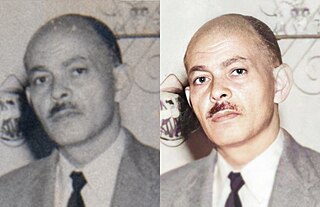Peak signal-to-noise ratio (PSNR) is an engineering term for the ratio between the maximum possible power of a signal and the power of corrupting noise that affects the fidelity of its representation. Because many signals have a very wide dynamic range, PSNR is usually expressed as a logarithmic quantity using the decibel scale.
The science of photography is the use of chemistry and physics in all aspects of photography. This applies to the camera, its lenses, physical operation of the camera, electronic camera internals, and the process of developing film in order to take and develop pictures properly.

Tone mapping is a technique used in image processing and computer graphics to map one set of colors to another to approximate the appearance of high-dynamic-range (HDR) images in a medium that has a more limited dynamic range. Print-outs, CRT or LCD monitors, and projectors all have a limited dynamic range that is inadequate to reproduce the full range of light intensities present in natural scenes. Tone mapping addresses the problem of strong contrast reduction from the scene radiance to the displayable range while preserving the image details and color appearance important to appreciate the original scene content.
Video quality is a characteristic of a video passed through a video transmission or processing system that describes perceived video degradation. Video processing systems may introduce some amount of distortion or artifacts in the video signal that negatively impact the user's perception of the system. For many stakeholders in video production and distribution, ensuring video quality is an important task.

Image noise is random variation of brightness or color information in images, and is usually an aspect of electronic noise. It can be produced by the image sensor and circuitry of a scanner or digital camera. Image noise can also originate in film grain and in the unavoidable shot noise of an ideal photon detector. Image noise is an undesirable by-product of image capture that obscures the desired information. Typically the term “image noise” is used to refer to noise in 2D images, not 3D images.
The structural similarityindex measure (SSIM) is a method for predicting the perceived quality of digital television and cinematic pictures, as well as other kinds of digital images and videos. It is also used for measuring the similarity between two images. The SSIM index is a full reference metric; in other words, the measurement or prediction of image quality is based on an initial uncompressed or distortion-free image as reference.

In optics, defocus is the aberration in which an image is simply out of focus. This aberration is familiar to anyone who has used a camera, videocamera, microscope, telescope, or binoculars. Optically, defocus refers to a translation of the focus along the optical axis away from the detection surface. In general, defocus reduces the sharpness and contrast of the image. What should be sharp, high-contrast edges in a scene become gradual transitions. Fine detail in the scene is blurred or even becomes invisible. Nearly all image-forming optical devices incorporate some form of focus adjustment to minimize defocus and maximize image quality.
The following outline is provided as an overview of and topical guide to photography:
Perceptual Evaluation of Audio Quality (PEAQ) is a standardized algorithm for objectively measuring perceived audio quality, developed in 1994–1998 by a joint venture of experts within Task Group 6Q of the International Telecommunication Union's Radiocommunication Sector (ITU-R). It was originally released as ITU-R Recommendation BS.1387 in 1998 and last updated in 2023. It utilizes software to simulate perceptual properties of the human ear and then integrates multiple model output variables into a single metric.
Perceptual Evaluation of Speech Quality (PESQ) is a family of standards comprising a test methodology for automated assessment of the speech quality as experienced by a user of a telephony system. It was standardized as Recommendation ITU-T P.862 in 2001. PESQ is used for objective voice quality testing by phone manufacturers, network equipment vendors and telecom operators. Its usage requires a license. The first edition of PESQ's successor POLQA entered into force in 2011.
Perceptual Evaluation of Video Quality(PEVQ) is an end-to-end (E2E) measurement algorithm to score the picture quality of a video presentation by means of a 5-point mean opinion score (MOS). It is, therefore, a video quality model. PEVQ was benchmarked by the Video Quality Experts Group (VQEG) in the course of the Multimedia Test Phase 2007–2008. Based on the performance results, in which the accuracy of PEVQ was tested against ratings obtained by human viewers, PEVQ became part of the new International Standard.

Foveated imaging is a digital image processing technique in which the image resolution, or amount of detail, varies across the image according to one or more "fixation points". A fixation point indicates the highest resolution region of the image and corresponds to the center of the eye's retina, the fovea.

Alan Conrad Bovik is an American engineer, vision scientist, and educator. He is a professor at the University of Texas at Austin (UT-Austin), where he holds the Cockrell Family Regents Endowed Chair in the Cockrell School of Engineering and is Director of the Laboratory for Image and Video Engineering (LIVE). He is a faculty member in the UT-Austin Department of Electrical and Computer Engineering, the Machine Learning Laboratory, the Institute for Neuroscience, and the Wireless Networking and Communications Group.
Scene statistics is a discipline within the field of perception. It is concerned with the statistical regularities related to scenes. It is based on the premise that a perceptual system is designed to interpret scenes.

Image restoration is the operation of taking a corrupt/noisy image and estimating the clean, original image. Corruption may come in many forms such as motion blur, noise and camera mis-focus. Image restoration is performed by reversing the process that blurred the image and such is performed by imaging a point source and use the point source image, which is called the Point Spread Function (PSF) to restore the image information lost to the blurring process.
Perceptual Objective Listening Quality Analysis (POLQA) was the working title of an ITU-T standard that covers a model to predict speech quality by means of analyzing digital speech signals. The model was standardized as Recommendation ITU-T P.863 in 2011. The second edition of the standard appeared in 2014, and the third, currently in-force edition was adopted in 2018 under the title Perceptual objective listening quality prediction.
The MOtion-tuned Video Integrity Evaluation (MOVIE) index is a model and set of algorithms for predicting the perceived quality of digital television and cinematic pictures, as well as other kinds of digital images and videos.
Video Multimethod Assessment Fusion (VMAF) is an objective full-reference video quality metric developed by Netflix in cooperation with the University of Southern California, The IPI/LS2N lab Nantes Université, and the Laboratory for Image and Video Engineering (LIVE) at The University of Texas at Austin. It predicts subjective video quality based on a reference and distorted video sequence. The metric can be used to evaluate the quality of different video codecs, encoders, encoding settings, or transmission variants.
Computational imaging is the process of indirectly forming images from measurements using algorithms that rely on a significant amount of computing. In contrast to traditional imaging, computational imaging systems involve a tight integration of the sensing system and the computation in order to form the images of interest. The ubiquitous availability of fast computing platforms, the advances in algorithms and modern sensing hardware is resulting in imaging systems with significantly enhanced capabilities. Computational Imaging systems cover a broad range of applications include computational microscopy, tomographic imaging, MRI, ultrasound imaging, computational photography, Synthetic Aperture Radar (SAR), seismic imaging etc. The integration of the sensing and the computation in computational imaging systems allows for accessing information which was otherwise not possible. For example:
Image fidelity, often referred to as the ability to discriminate between two images or how closely the image represents the real source distribution. Different from image quality, which is often referred to as the subject preference for one image over another, image fidelity represents to the ability of a process to render an image accurately, without any visible distortion or information loss. The two terms are often used interchangeably, but they are not the same.







